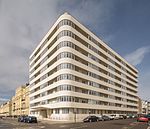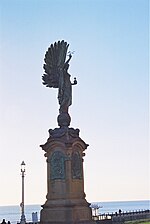Norfolk Hotel, Brighton
1865 establishments in EnglandGrade II listed buildings in East SussexHotel buildings completed in 1865Hotels established in 1865Hotels in Brighton and Hove ... and 2 more
Renaissance Revival architecture in the United KingdomUse British English from November 2013

The Norfolk Hotel (currently branded as the Mercure Brighton Seafront Hotel, and previously as the Ramada Jarvis Hotel Brighton and other names) is a 4-star hotel in the seaside resort of Brighton, part of the English city of Brighton and Hove. Designed in 1865 by architect Horatio Nelson Goulty, it replaced an earlier building called the Norfolk Inn and is one of several large Victorian hotels along the seafront. The French Renaissance Revival-style building, recalling E.M. Barry's major London hotels, is "tall, to make a show": the development of the passenger lift a few years earlier allowed larger hotels to be built. It is a Grade II listed building.
Excerpt from the Wikipedia article Norfolk Hotel, Brighton (License: CC BY-SA 3.0, Authors, Images).Norfolk Hotel, Brighton
Norfolk Street, Brighton
Geographical coordinates (GPS) Address Nearby Places Show on map
Geographical coordinates (GPS)
| Latitude | Longitude |
|---|---|
| N 50.8228 ° | E -0.1554 ° |
Address
Mercure Btighton Seafront
Norfolk Street 149
BN1 2PP Brighton
England, United Kingdom
Open on Google Maps











